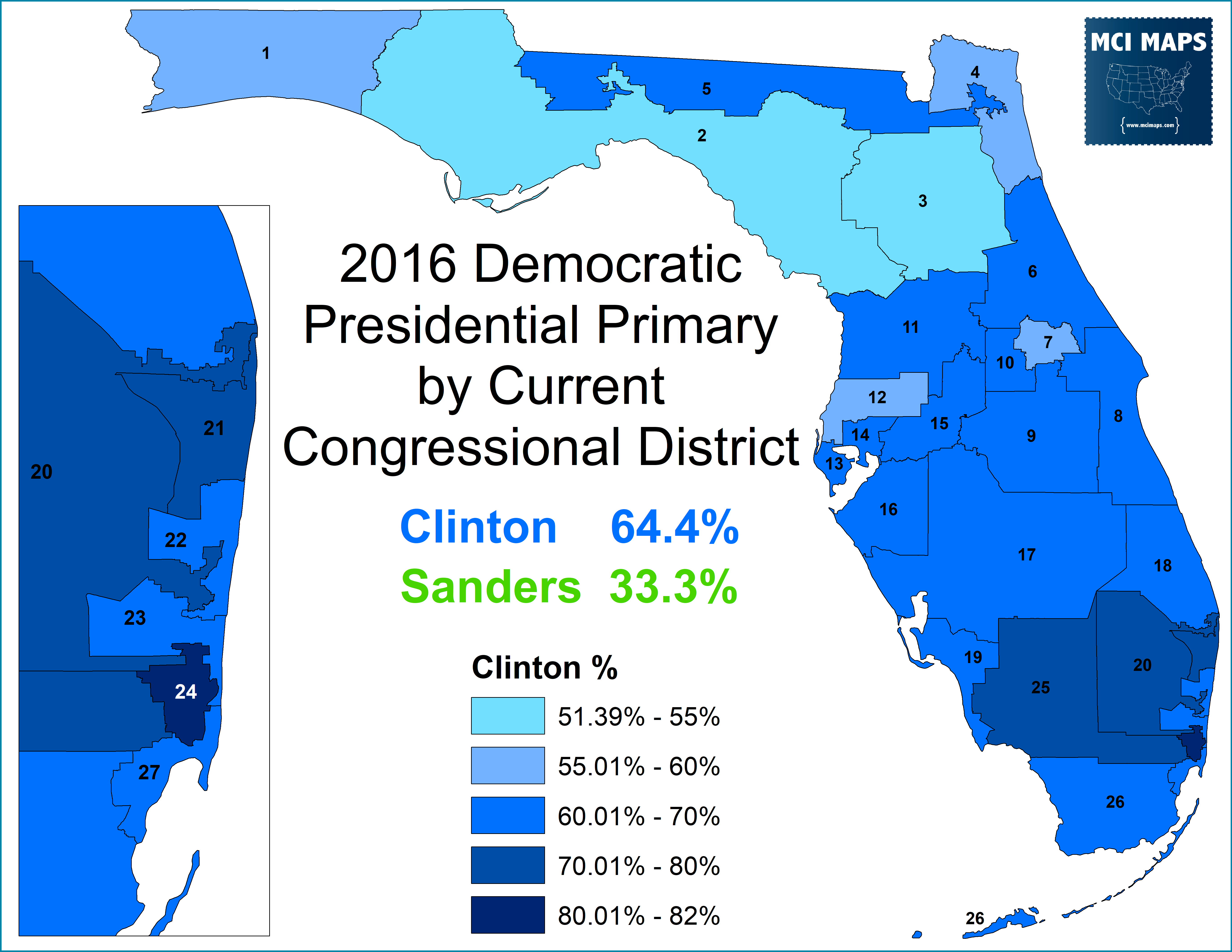On Tuesday, amid a Coronavirus global pandemic, voters will flock to the polls in for the Democratic Presidential primaries in Florida, Ohio, Illinois, and Arizona. Here in Florida, over one million ballots have already been cast on the democratic side. The race is down to Biden and Sanders, and pollsters indicate the sunshine state will be resounding victory for Joe Biden. However, since all delegates are allocated proportionally, the final margins matter. With that in mind, I want to examine Democratic politics in Florida and what to watch for this Tuesday in Florida.
The 2016 Presidential Primary
The 2016 Democratic primary in Florida was not a competitive affair. Florida voted the same day as Ohio, Illinois, North Carolina, and Missouri. The contest was a week after Sanders’ upset win in Michigan, which had given new life to his campaign. Sanders’ biggest focus was in Ohio, Illinois, and Missouri. Polls all showed Clinton with a commanding lead in Florida. Overall the state’s demographics (less white, older democrats) were not strong for Sanders. In the end, Sanders won only a few rural counties and lost the state by 31%.
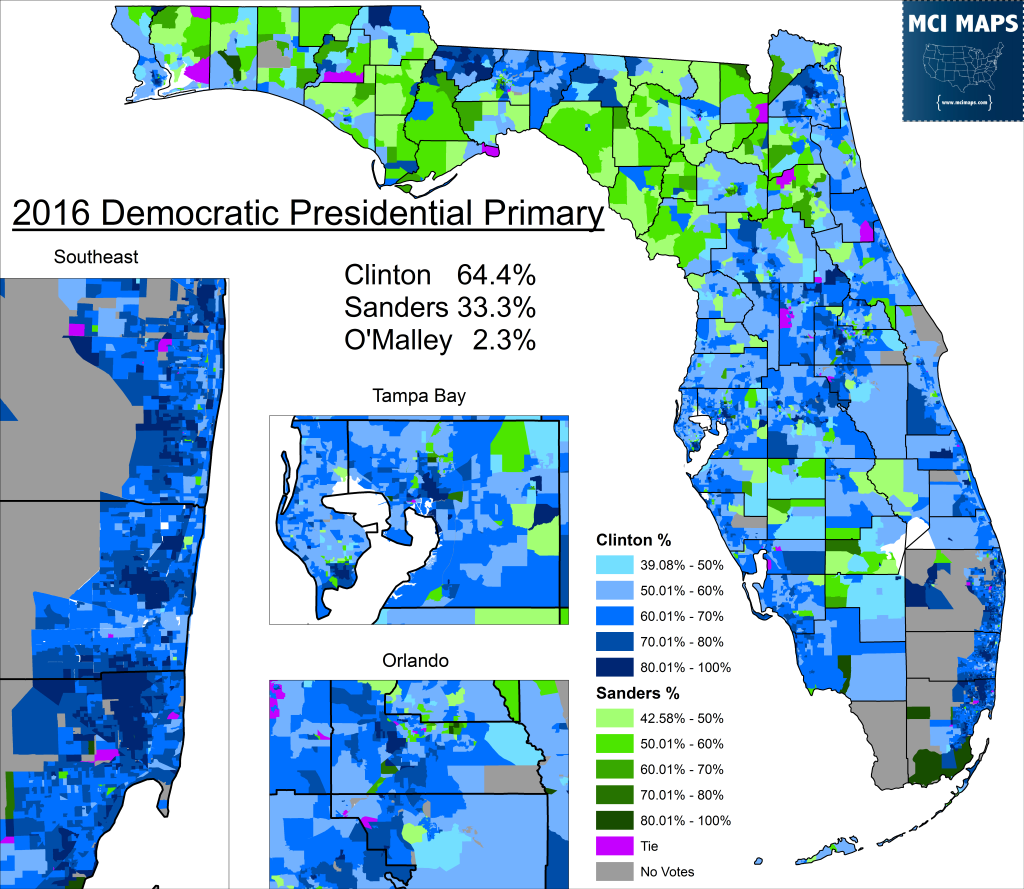
Sanders won zero congressional districts in the state. The contest was actually held under the older lines. The results below are for the current districts. Under both maps, Clinton swept all districts.
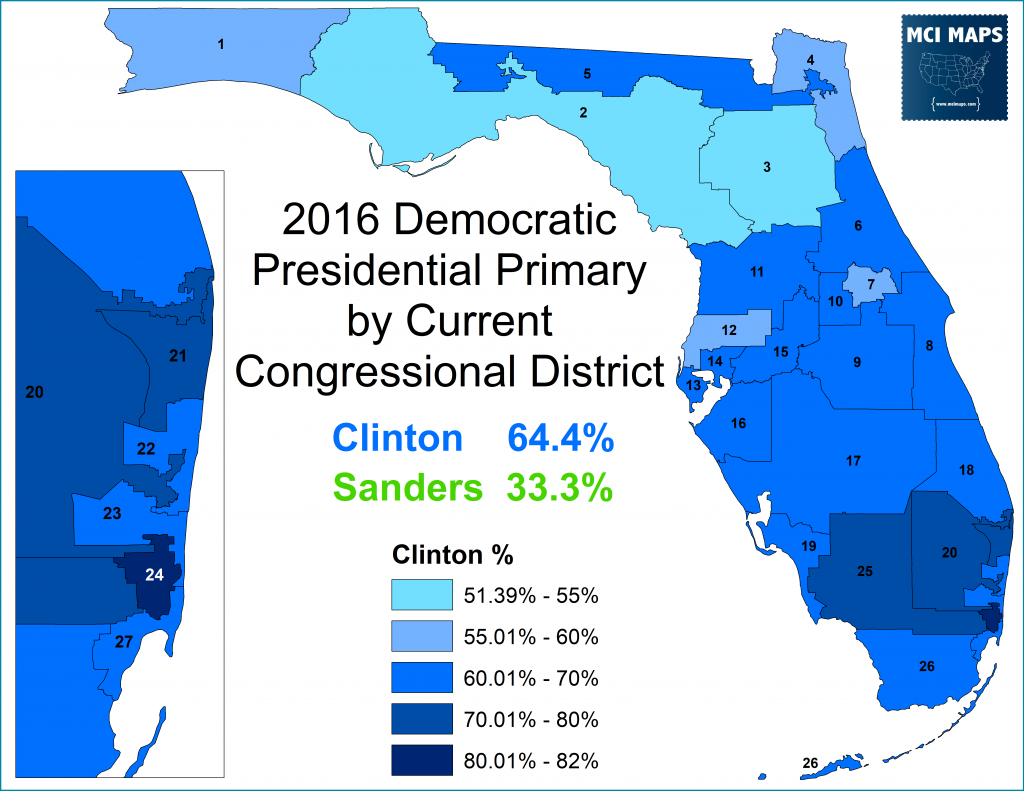
The delegate breakdown was 141 for Clinton and 73 for Sanders – a 68 delegate margin.
Sanders’ biggest problem in Florida was major losses with African-American and Hispanic voters. Neither group were good for him in 2016. In addition, suburban democratic whites and retires were a strong Clinton group. Sanders’ best groups in Florida were the college campuses and the more rural North Florida counties. His North Florida showing, however, was heavily a result of protest votes from anti-Clinton conservatives. North Florida democrats have a long history of protest voting. Due to Florida being a closed primary state, the democrats of North Florida, many of whom vote democratic locally but Republican federally, often cast scattered and protest votes against prominent Democratic candidates in primaries.
The combination of protest votes and college students allowed Sanders to win 1 of the 120 state house districts in the state. Sanders scored a plurality win in HD21, which linked University of Florida on the east and included conservative dixiecrat Gilchrist and Dixie Counties.
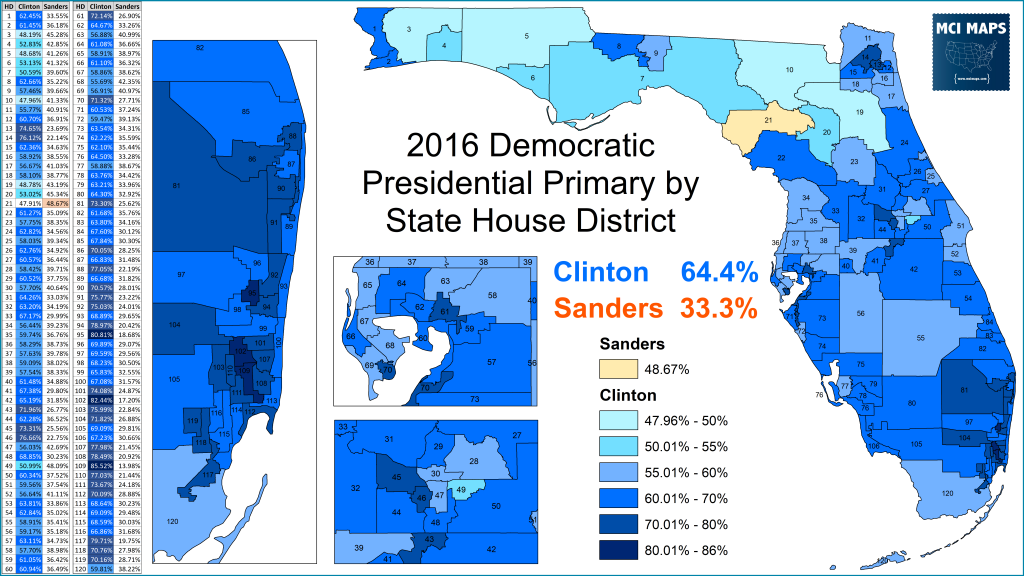
Sanders’ delegate loss in Florida was an under-reported story but a key factor in Clinton’s continued delegate lead moving forward. The state didn’t need to be won by Sanders, but the margin he lost it by was very damaging to his chances.
Florida’s Protest Votes
Florida’s combination of closed primaries ancestral democratic counties (democratic down-ballot and in registration, red at the top of the ticket) has led to a protest vote phenomenon that has been going on for years. It is an important factor to consider while watching votes come in Tuesday.
North Florida’s conservative protest vote in 2016 could also be seen with the votes cast for Martin O’Malley, who had long been out of the race. O’Malley only secured 2% statewide, but scored double digit margins in several North Florida counties and some of the rural farm counties in the middle of the state.
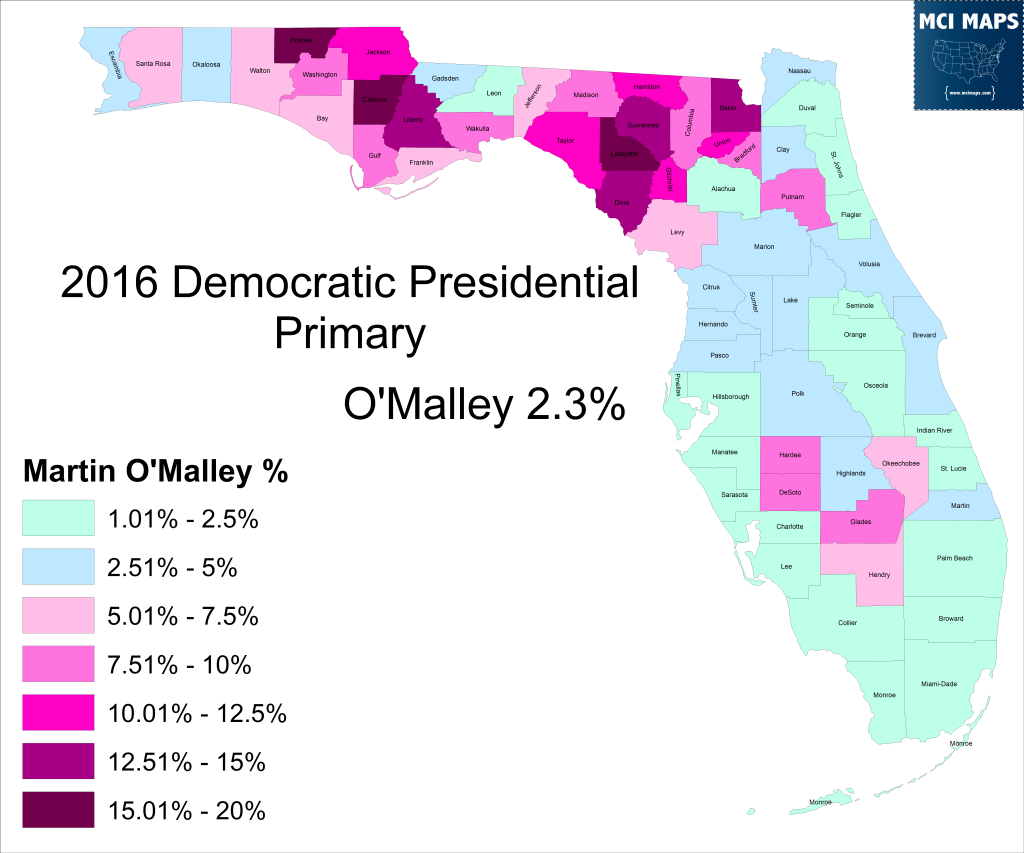
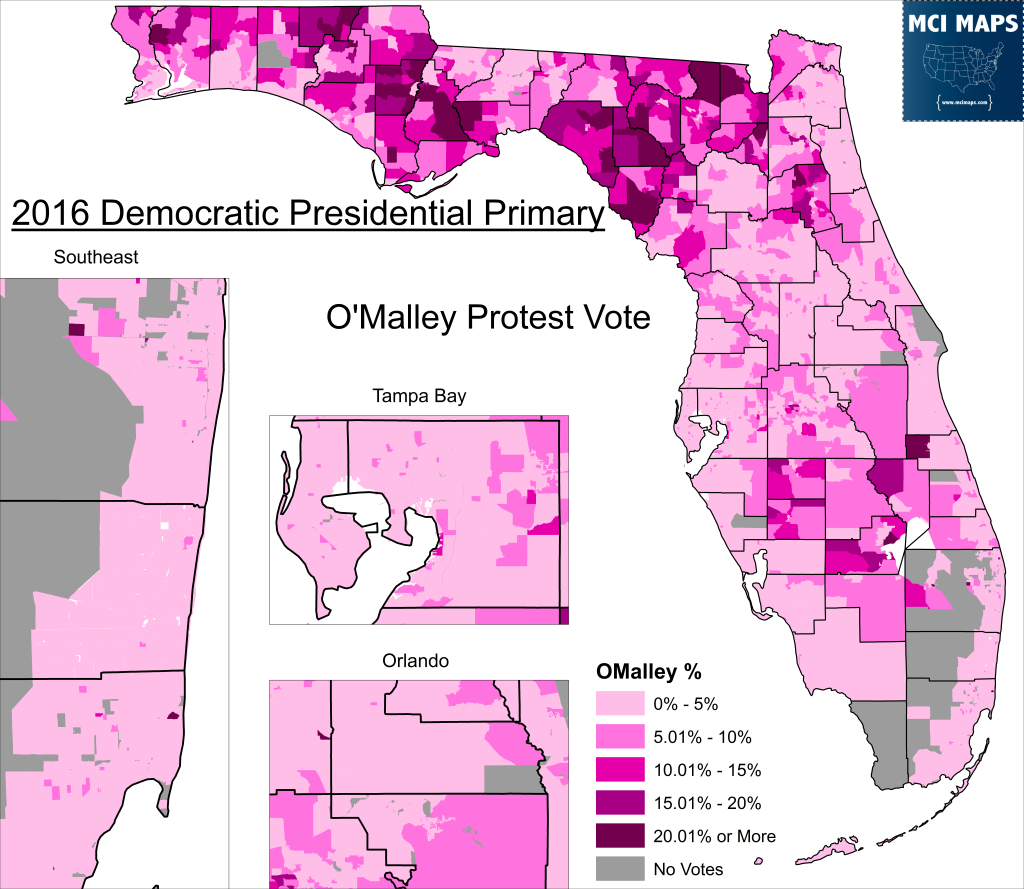
His best showing was in HD7, the last of Florida ancestrally democratic house districts.
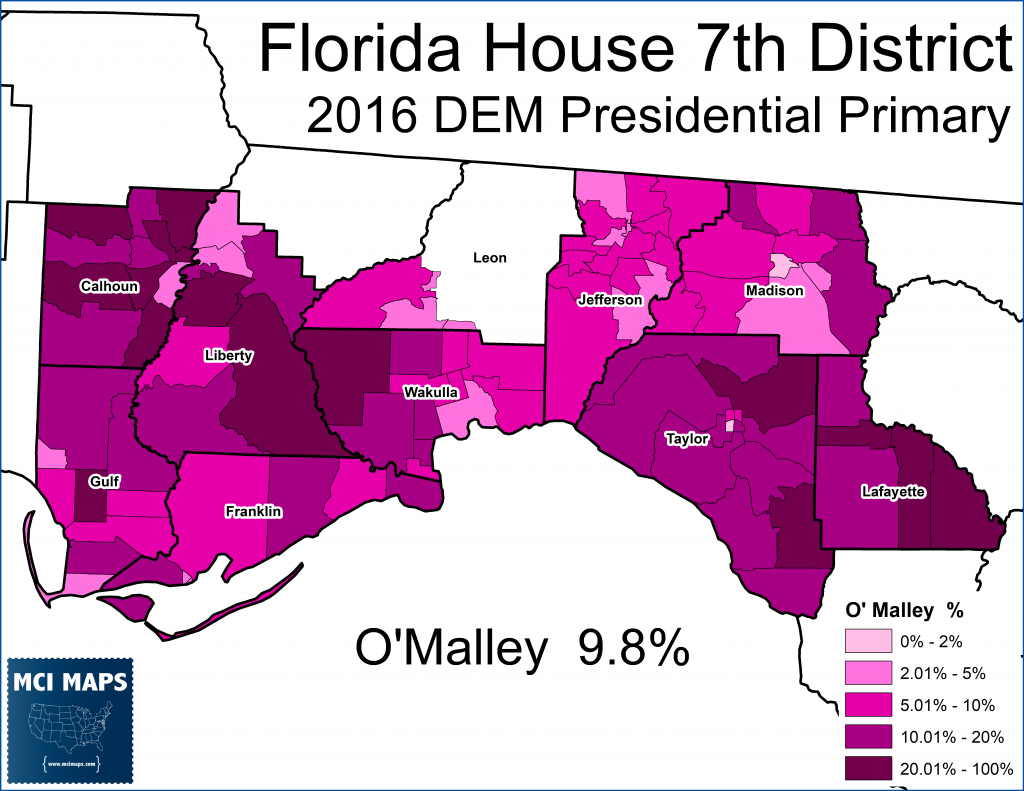
The protest vote phenomenon was also seen in 2008 when John Edwards secured votes in several North Florida counties despite his campaign being on the verge of ending.

Protest votes can also been seen with ballots flat out being left blank. In the 2014 Florida Governor primary, almost 3% of ballots were left blank. Many North Florida counties saw democrats show up to vote for the local primaries for county commission (or other local offices) but leave the top race blank.
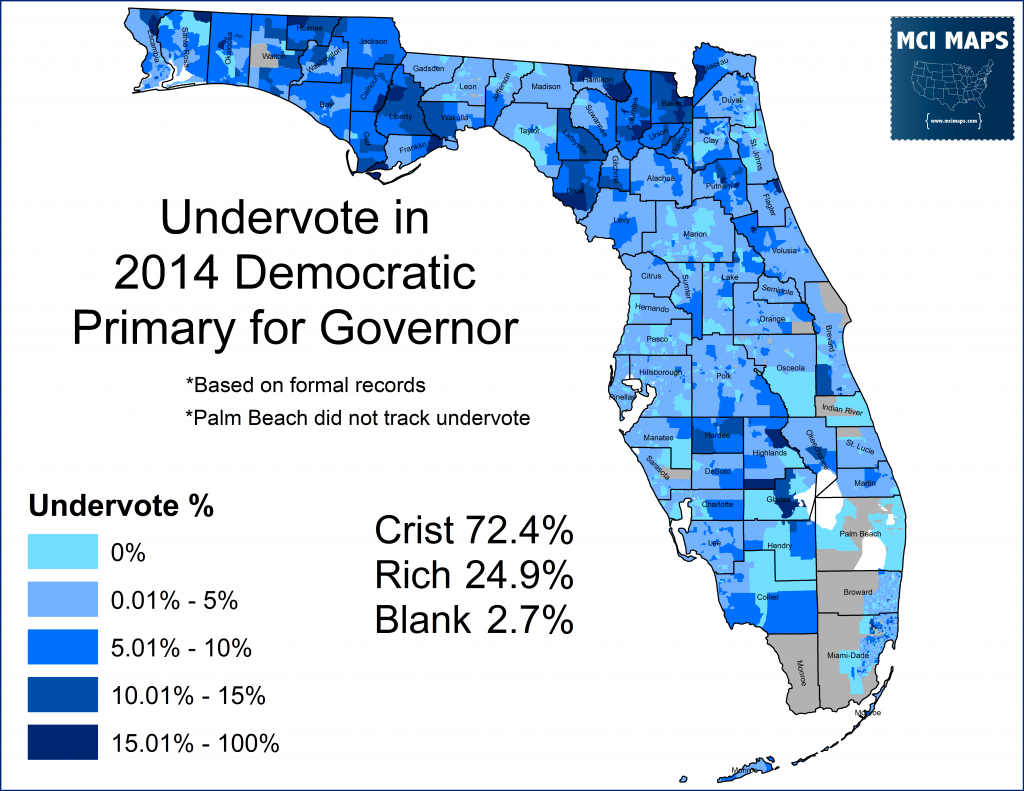
This continued in 2016. The Presidential primary saw a smaller blank vote, just around 1%. However, that itself is staggering because that was the only major race on anyone’s ballot. A few towns had council races, but a vast majority of ballots were just President. In Lafayette and Baker counties, over 5% of democrats showed up and left their only race to vote on blank! On possible explanation for this could be some democrats showing up thinking they could vote in the Trump vs Rubio GOP primary, but then being informed about the closed primary rule.
In August of 2016, during the regular primaries, the US Senate primary, which saw Patrick Murphy easily defeat Alan Grayson, saw a much higher blank vote of 5%.
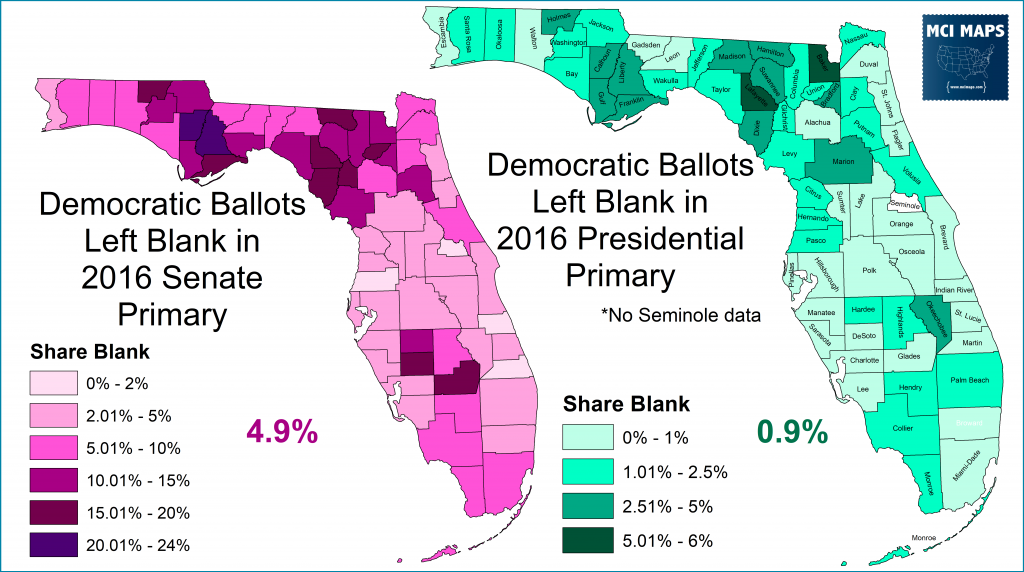
The blank vote in the 2016 Presidential primary was small overall but another factor was that turnout was down in several of these counties. Despite Democrats doubling the turnout from the 2014 Gubernatorial primary, turnout barely rose or flat out dropped in several North Florida counties.
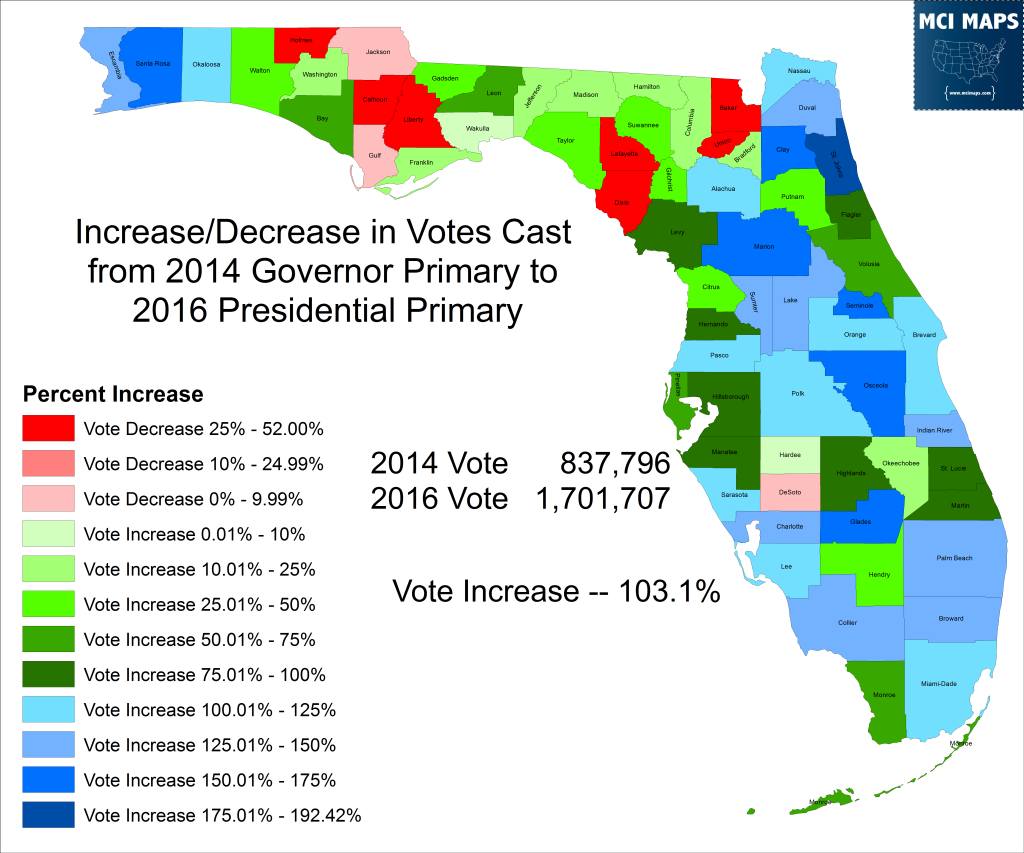
Part of this was democrats changing registration to the GOP or folks staying home because they didn’t like their option. Even still, 5% of Baker democrats showed up and turned their ballot right back in.
History tells us we will see protest votes again on Tuesday – likely represented in scatted votes for other candidates. However, each election cycle is likely to see less protest votes going forward. Each cycle is seeing democratic registration in rural, conservative counties drop. Since 2016, democratic registration has dropped drastically across the rural counties while rising in the urban counties. Several conservative counties that were Democratic registered in 2016 are now Republican.

This change will lead to less protest votes overall.
The 2020 Primary
The 2020 primary in Florida has taken on a similar vibe to 2016. The state has been written off as lock for Joe Biden. Even before the outbreak of the coronavirus, the state seemed to be less likely to get a good deal of attention from candidates. The fight in Florida was originally a fight between Biden and Bloomberg, who briefly surged to first in the polls amid his advertising blitz. Sanders has never registered much support here. The latest poll gives Biden a 69-14 lead over Sanders here.
Racial Dynamics
The racial makeup of the primary should be the least white of any primary in the past. With each cycle, the white share of the democratic primary slowly falls.
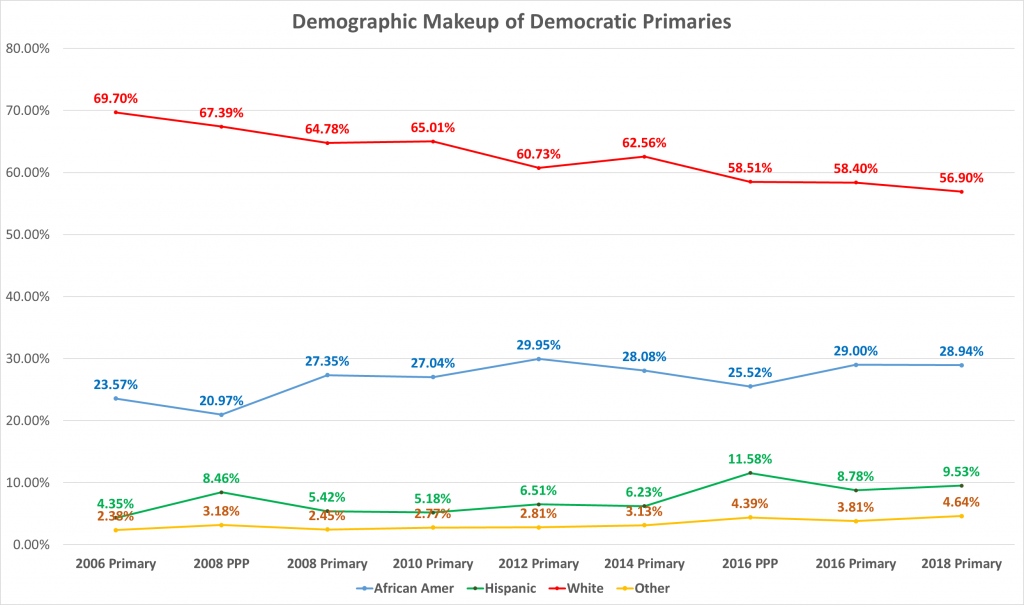
In terms of raw votes, the non-white voting black is continuing to rise. On top of this, turnout has been up in recent years. The 2018 primary for governor had turnout comparable to a Presidential primary, which always top the charts for Democrats. The party still has not topped the turnout from its 2008 primary.
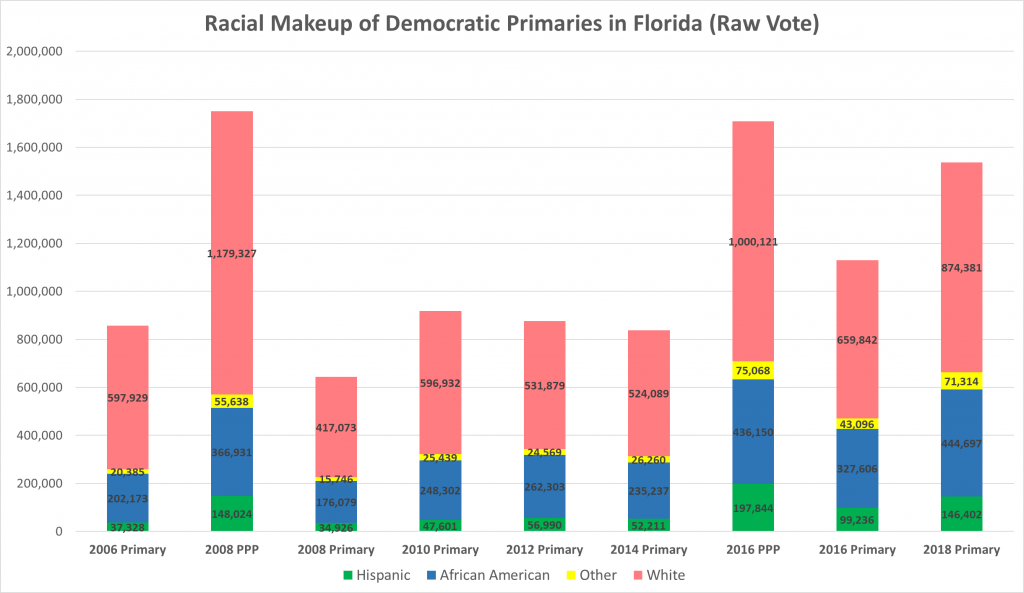
White share of democrats have fallen especially quick in North Florida, the farm counties, and parts of the I-4 corridor. This will also play a role in reducing protest votes in these small counties – as the only democrats left are becoming more and more dominated by Hispanics or African-Americans; and less so by conservative whites.
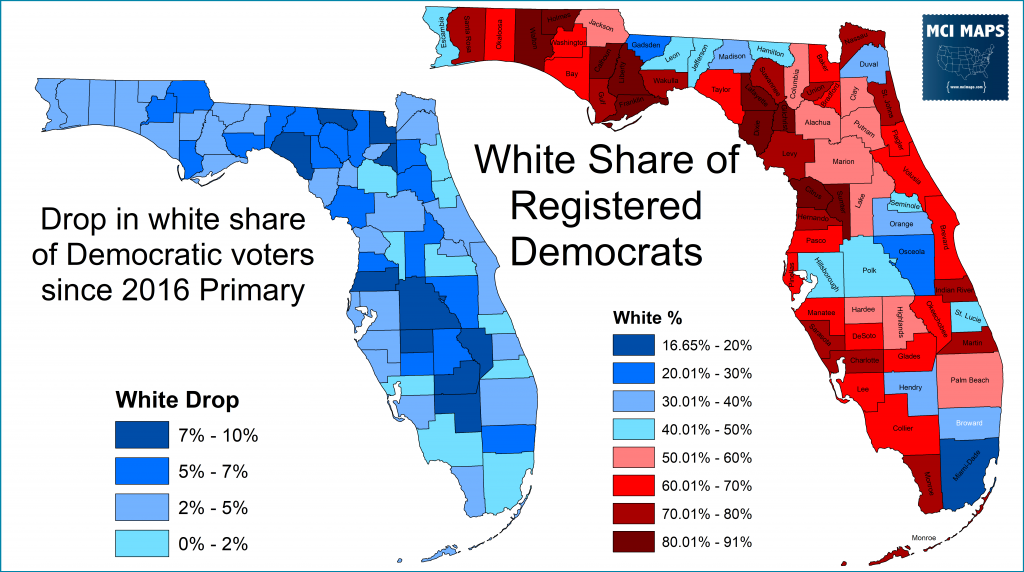
The growing diversity of the Florida primary electorate was a critical aspect of Andrew Gillum’s surprise win in the 2018 Florida Governor primary. His win was heavily driven by strong margins in the African-American precincts, as well as good showings with Hispanics in the Orlando region. Gwen Graham, meanwhile, dominated with white voters across the state. Philip Levine, meanwhile, did best in his Miami-base, taking white voters in South Florida and the Hispanic Dade regions.
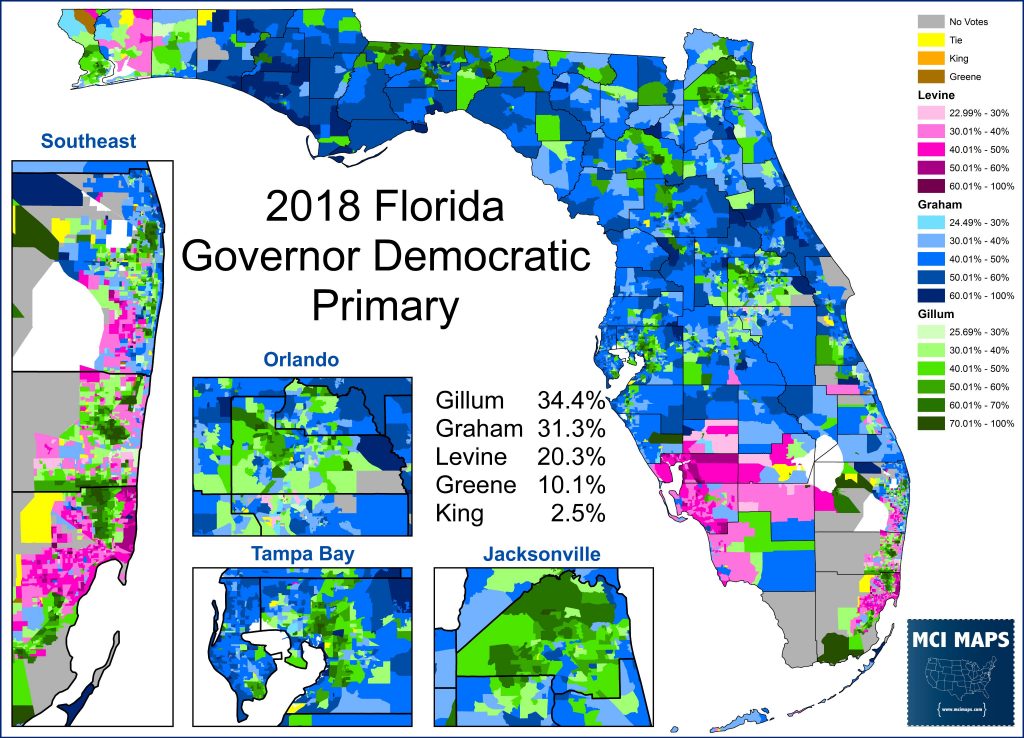
Look at that precinct map compared to the below map of racial makeup of registered democrats by precinct. Gillum’s wins heavily correlate with African-American voters.
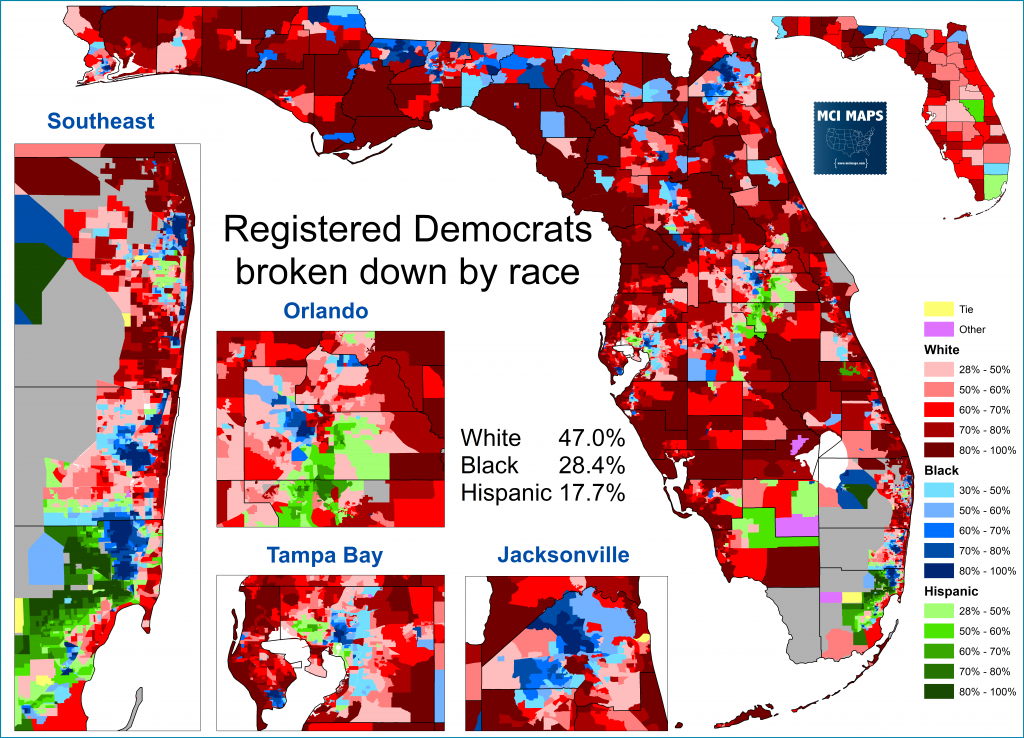
Gillum’s win has sometimes been simplified as capturing the liberal Sanders wing of the democratic primary. However, their respective showings were very different. Sanders lost handily in the non-white areas in his run and did much stronger in North Florida. Their only major overall was college campus support.
Also notice that the registration breakdown shows a more racially diverse party than the turnout in the past has been. Overall white voters still outperform their share of registration thanks to stronger turnout.
Changing Coalitions from 2016
This election cycle, Sanders is performing much better with Hispanic voters than he did in 2016. He won Hispanic voters in Nevada, Texas, California, and Michigan. Sanders has also done a bit better with African-Americans, but is still losing them by large margins. However, he has performed worse with rural and working class whites. As I discussed regarding North Florida, Sanders got many anti-Clinton protest votes in many states. This was also true in places like West Virginia and Kentucky and was seen just last week in Michigan.
These shifts from 2016 can be seen in my map of the southeast states. The map shows how the Clinton-Sanders margins have changed vs the Biden-Sanders breakdown. Blue counties mean Biden has a better margin than Clinton did, while orange means a worse margin.
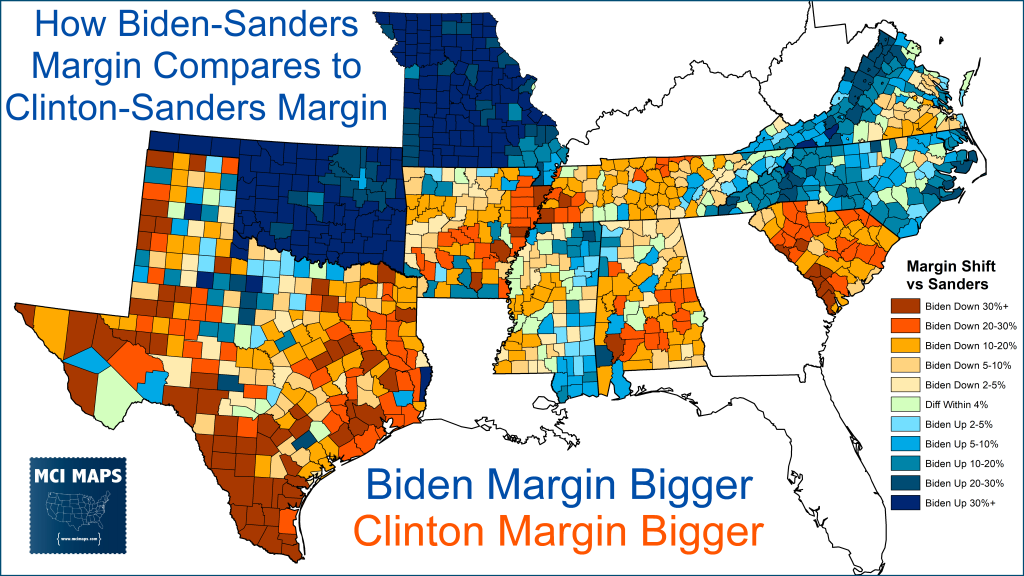
Sanders has improved margins in African-American and Hispanic areas. However, areas like western Virginia and North Carolina show some of his vote there in 2016 was more anti-Clinton driven. His collapse in very conservative Oklahoma (where 2016 exits showed him winning “Conservative” voters) perfectly highlights the anti-Clinton effect on that primary. Missouri’s rural middle counties also show a similar collapse for Sanders.
If these past races are any indicator, Biden should improve drastically in much of the white North Florida counties. Sanders, meanwhile, would normally be hoping to improve with Hispanics. However, recent polls still show Biden with over 60% of Florida’s Hispanic vote. Part of this is absolutely due to Sanders’ Castro controversy, but its also worth pointing out Florida’s Hispanic population is unique and different from many of the other states that have voted. Florida’s Hispanic population is heavily made up of Cubans, Puerto Ricans, and assorted South American countries. Any difference in Puerto Rican support (Orlando region) and Cuban support (Dade) is something I will be watching Tuesday.
The Effects of Coronavirus
One major x-factor in this primary has been the outbreak of coronavirus. The global pandemic, which is very deadly for seniors, has resulted in major pushes for folks to avoid crowded areas to help stop the spread of the disease. Two states, Georgia and Louisiana, have announced delays in their primaries. Florida, Ohio, Illinois and Arizona, however, have all announced they move forward Tuesday. In Florida, over a million democratic votes have already been cast via mail and early vote.
In addition to the overall desire for everyone to not catch the disease (and risk its spread) the situation can be especially concerning for seniors. Many areas have already moved polling sites out of senior communities for those who don’t live directly there. Counties have also been scrambling to make voting as safe and as accessible as possible. How much the virus will effect senior turnout on Tuesday remains to be seen. So far, seniors make up a far higher share of the vote cast than they make up as a share of registration.
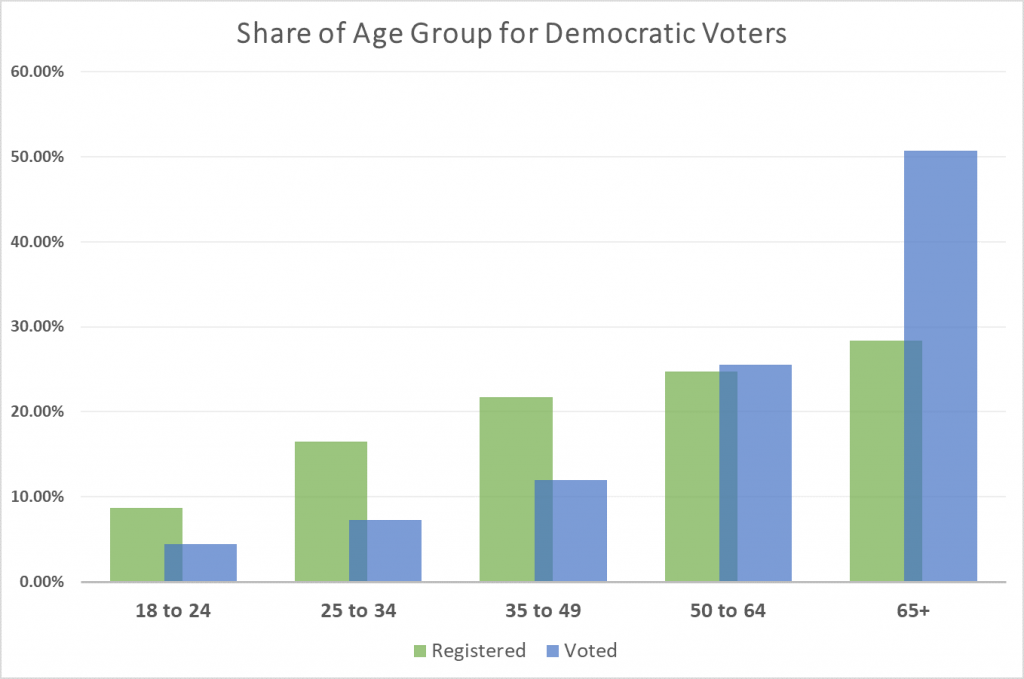
This is not especially surprising, as seniors vote far more often before election say. In the 2016 primary, 60% of seniors voted before election day, while younger voters often wait till the day of.

As a result of this, the share of votes cast right now is still far more white than it was in 2016. However, that should drop with the final early vote numbers and election day.
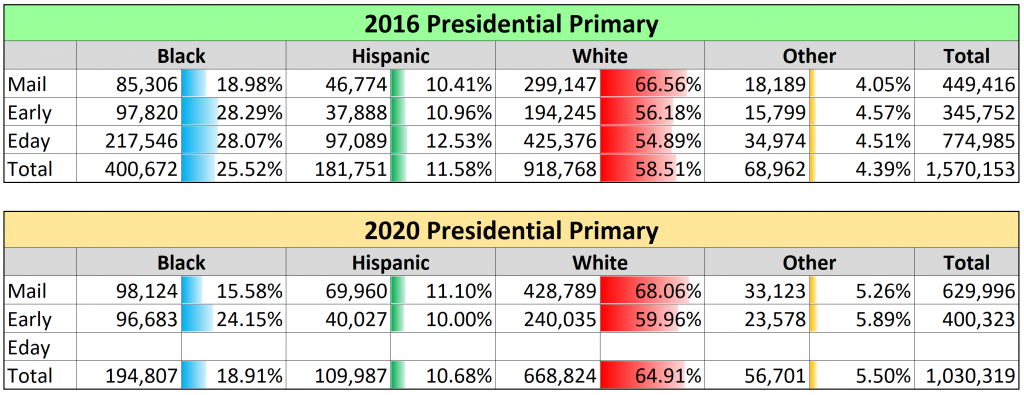
Of course, the campaign disruptions and virus concerns could effect these figures. One notable issue is that Sunday before the election is often “Souls to the Polls,” an event in many urban counties were African-Americans go and vote early right after church service. The virus has caused different churches to close or go to online sermons and depending on the area, planned rallies are being scrapped while others continue. This could all effect final turnout, especially as the race is viewed safe for Biden.
The Forgotten Hurricane
Major disruptions aren’t new to Florida and their effects on elections here can be seen as early as late as 2018. That October, a Category 5 storm, Hurricane Michael, made landfall in the Florida panhandle. It decimated coastal communities and maintained strength as it carved its way through the interior counties and into Georgia. It was the most powerful storm to every strike the region and the most powerful landfall since Hurricane Andrew in 1992.

The storm’s landfall fell in much more rural communities that dot what is known as the “Forgotten Coast.” As such, the Hurricane’s effects, which were so damaging that many of the small counties still have not recovered, are largely forgotten by the rest of Florida. The storms effects were very isolated to the region it hit. The storm made landfall on October 10th. This was the power outage map on October 11th.

Several days later, several counties were largely out of power. Homes were destroyed, cities devastated, and natural resources decimated. Jackson County, on the border, had fields of huge trees that were snapped in half like toothpicks.

The counties had to act quickly to allow people to cast ballots for the upcoming Gubernatorial election. Many precinct buildings were damaged, so mega voting centers were set up. Even with all efforts made, turnout still lagged in several of the effected counties.
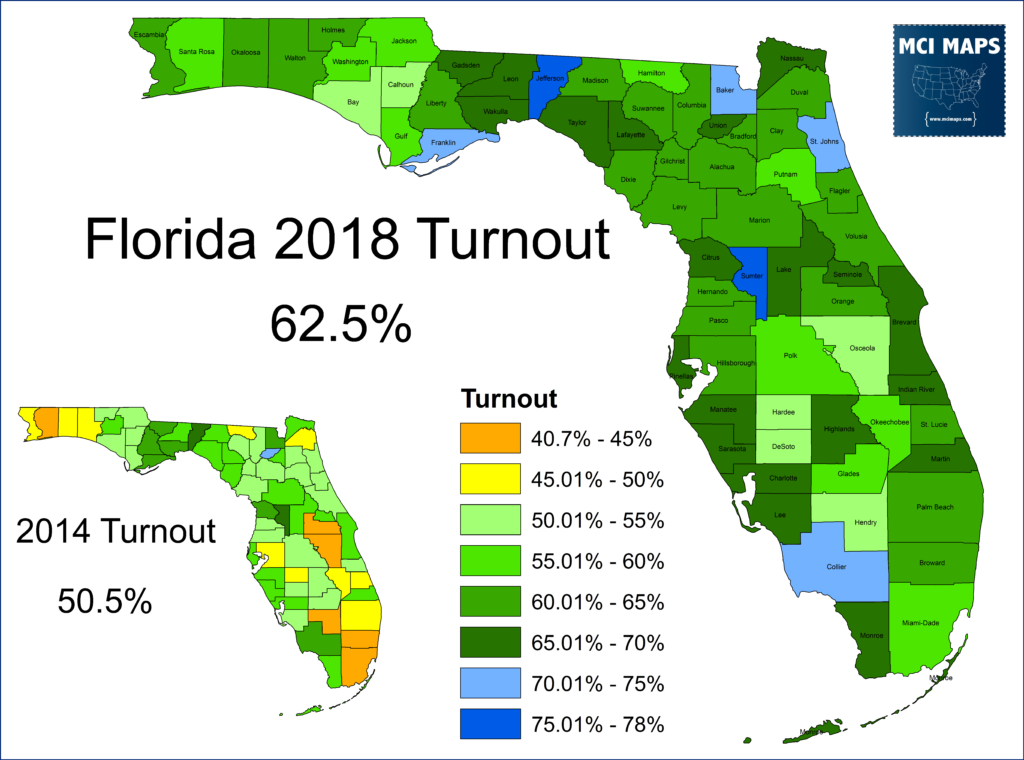
The effects of the storm are most notable when comparing the shift in registration from 2014 to 2018.
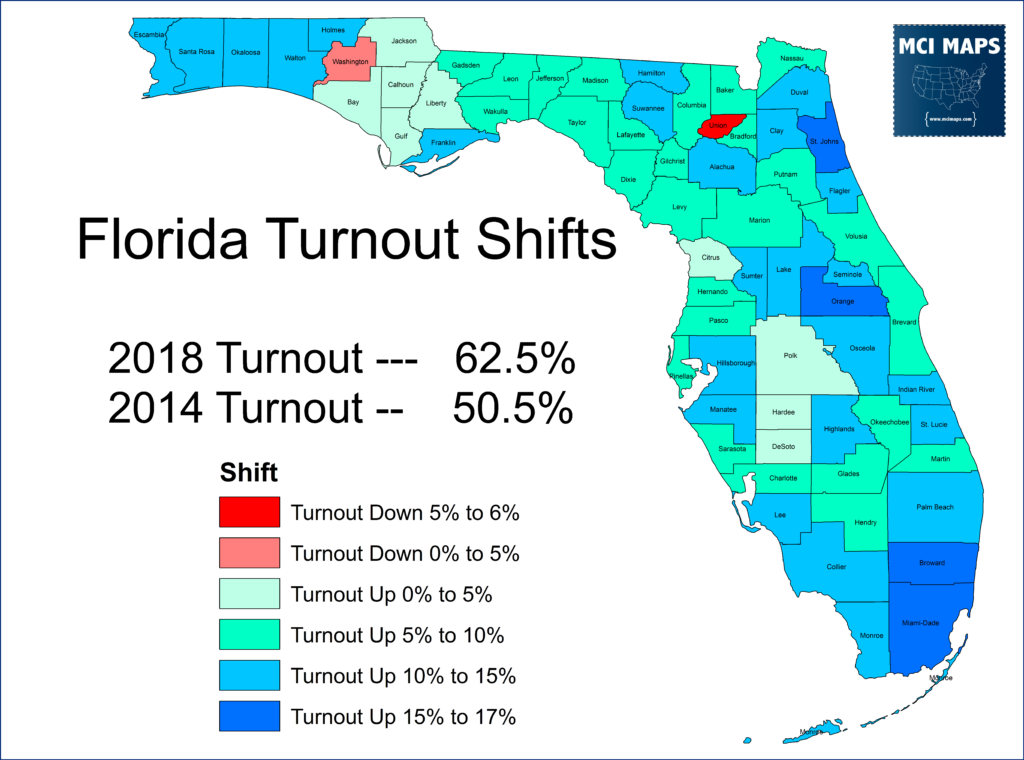
Natural disasters and diseases can effect turnout. Hurricane Michael has a profound effect on turnout in the areas it hit. How much coronavirus effects turnout on Tuesday remains to be seen.
Where the votes will come from
Florida has 67 counties, but not all are equal. In a democratic primary, big margins in the urban cores can fuel a win. This was especially the case in 2018 with Gillum’s win. Despite losing a majority of counties, Gillum racked up five-figure margins over Graham in populous Broward, Dade, and Duval.

These margins were able to override a long list of modest or small losses. Poor showings in North Florida white counties only meant losing a handful of actual votes.
The 2018 dynamic will be true in 2020 as well. The big vote blocks are in the urban counties – especially southeast Florida. Almost 30% of the vote could come from Dade, Broward, and Palm.
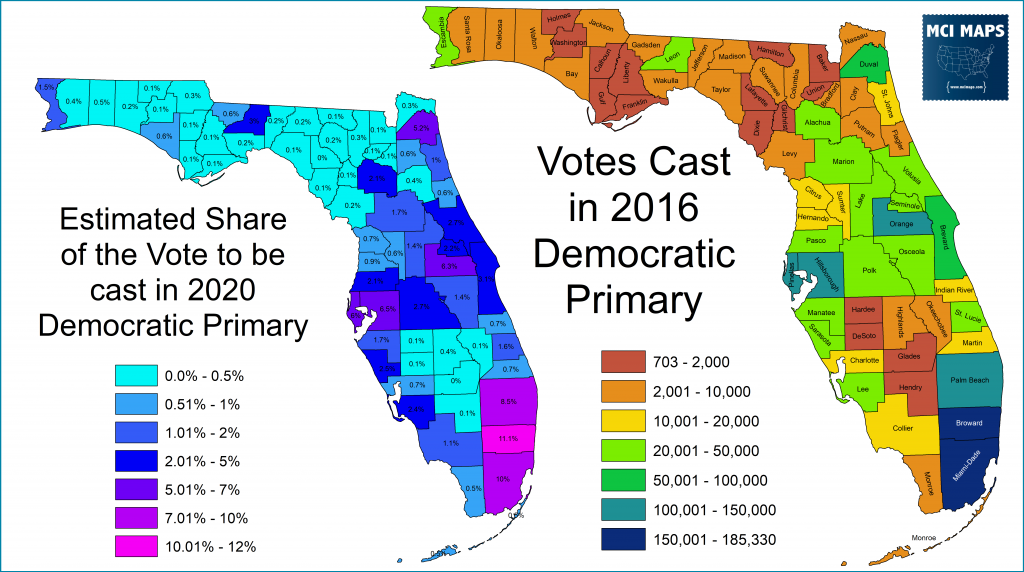
The panhandle, a region Sanders is expected to under-perform in compared to 2016, has so little share of the vote that it won’t hurt him as much as some might think.
Conclusion
Florida will be called for Biden once the polls close on Tuesday. Another Presidential cycle has passed with the state getting little attention. However, the results will still effect the campaign going forward. The final margin could result in a better-than-expected showing for Sanders, or a delegate bonanza for Biden. The resulting delegate gap could reinforce the growing narrative that Sanders has no real path to the nomination.
Whether Sanders remains in the race after Tuesday, however, is something he knows. The margin in Florida could help him make up his mind.

